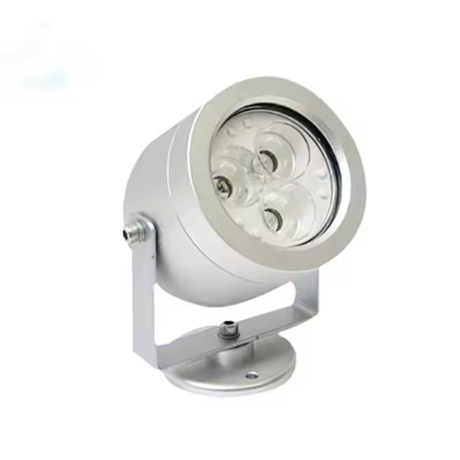CNC Hardware Customization Case: High-Precision Aluminum Alloy Housing Customization Project for LED Floodlights
1. Project Background
In the field of outdoor lighting, factors such as product appearance design, structural stability, and heat dissipation performance directly affect the product’s market competitiveness. “Starlight Lighting Co., Ltd.”, an enterprise focusing on the research, development and production of high-end outdoor lighting equipment, needed to customize a batch of high-precision aluminum alloy housings in order to launch a LED floodlight with leading industry level. The housing not only needs to meet the requirements of complex structural design to ensure accurate adaptation to internal components such as lamp beads and circuit modules, but also needs to have excellent heat dissipation capacity and resistance to harsh outdoor environments (such as wind, sun, rain, corrosion, etc.). At the same time, it should present a simple, atmospheric and technological metal texture in appearance to enhance the overall grade of the product. Since traditional hardware processing methods are difficult to meet such high precision and complex process requirements, after many investigations, Starlight Lighting Co., Ltd. finally chose to cooperate with us in CNC hardware customization.
2. Detailed Customer Requirements
(1) Material Requirements
In order to take into account strength, corrosion resistance and excellent heat dissipation performance, the customer clearly specified the use of 6061 aluminum alloy as the raw material for the housing. 6061 aluminum alloy has good mechanical properties. After appropriate processing and treatment, it can meet the structural strength requirements of outdoor lighting equipment; At the same time, it has good chemical stability and can effectively resist corrosion factors in the outdoor environment; In addition, the good thermal conductivity of aluminum alloy also helps the heat generated by LED lamp beads to dissipate quickly, ensuring the service life of the lamp.
(2) Precision Requirements
The dimensional accuracy of the housing is the key to ensuring the assembly quality of the product. The customer requires that the dimensional tolerance of each component of the housing be strictly controlled within ± 0.02mm. For example, the connecting holes between the main body of the housing and the bracket must ensure accurate cooperation with fasteners after multiple installations and disassembly without loosening or jamming; The size error of the card slot inside the housing for fixing the lamp bead circuit board shall be extremely small to ensure that the circuit board is installed in an accurate position without affecting the light-emitting angle and lighting effect of the lamp bead.
(3) Appearance and Surface Treatment Requirements
In terms of appearance, the surface of the housing is required to reach a mirror level of smoothness without any burrs, scratches or unevenness, and the overall appearance is silver gray metal luster, giving people a delicate and high-end visual experience. In order to enhance the wear resistance, UV resistance and corrosion resistance of the housing, the surface treatment process is selected as anodic oxidation, and the oxide layer should be uniform and dense, with a thickness controlled between 10 – 15μm, and the color should be highly consistent without local color difference.
(4) Structural Complexity Requirements
The structure of the LED floodlight housing is relatively complex, including multiple parts such as the main shell, adjustable angle bracket and base with mounting holes. There is a cavity inside the main shell for accommodating lamp beads and circuit modules, and the inner wall of the cavity needs to have accurate positioning bosses and heat dissipation fin structures; The bracket part should not only realize the flexible adjustment of the lamp body angle, but also ensure that it can be stably fixed after being adjusted to any angle. The connection part between the bracket and the main shell and the base has a complex structural design, which requires high processing accuracy.
3. Customization Process and Implementation
(1) Pre-Technical Preparation
- Drawing and Process Analysis: Our technical team carefully studied the 3D model, 2D engineering drawings and detailed parameters provided by the customer. Aiming at the complex structure, the feasibility analysis of CNC machining process is carried out, including selecting appropriate cutters, setting machining paths and cutting parameters, etc.
- Tool and Equipment Selection: According to the material characteristics of aluminum alloy and processing accuracy requirements, high-precision cemented carbide cutters, such as end mills, drills and taps, are selected. At the same time, the most advanced five-axis CNC machining center is deployed, which has higher machining freedom and precision control ability and can better meet the machining requirements of complex structures.
(2) CNC Machining Process
- Raw Material Pretreatment: Firstly, the 6061 aluminum alloy raw material is inspected to ensure that its composition meets the standards and there are no defects such as cracks and impurities. Then, according to the processing requirements, the raw materials are cut into appropriate blank sizes to prepare for subsequent processing.
- Multi-Process CNC Machining
- Machining of Main Shell: Fix the aluminum alloy blank on the worktable of the CNC machining center, and ensure the clamping stability through professional fixtures. According to the preset machining path, rough machining is carried out first to quickly remove most of the excess material and form the approximate shape of the main shell. During rough machining, the load, cutting temperature and other parameters of the machining center are closely monitored to prevent machining errors caused by overload or overheating. Then, semi-finishing is carried out to further refine the shape and process the cavity, positioning boss and heat dissipation fin structure inside the main body. At this time, the dimensional accuracy is controlled within ± 0.03mm. Finally, finishing is carried out. By using the method of small cutting amount and high rotation speed, the inner and outer surfaces of the main body are finely machined to ensure that the dimensional tolerance is strictly controlled within ± 0.02mm and the surface roughness reaches below Ra0.8μm.
- Machining of Bracket and Base: For the bracket and base, the process of rough machining, semi-finishing and finishing is also followed. The key part of the bracket is to process the rotating shaft hole connected with the main shell, the angle adjustment limit structure and the mounting surface connected with the base; The base needs to process the mounting holes, positioning pin holes and matching surfaces connected with the bracket for fixing on the wall or other supports. All machining processes strictly ensure dimensional accuracy and surface quality.
- Machining Process Monitoring: During the whole CNC machining process, the on-line detection system 自带 by the machining center is used to measure and feed back key dimensions in real time. At the same time, technicians sample and test the machined parts regularly, and use high-precision coordinate measuring machines to comprehensively detect the three-dimensional dimensions of the parts to ensure that each machining step meets the precision requirements. Once deviations are found, the machining parameters are adjusted in time.
(3) Surface Treatment Process
- Deburring and Cleaning: After CNC machining, all parts are comprehensively deburred. The combination of manual hand-held fine sandpaper grinding and special deburring tools is adopted to carefully remove burrs at the edges and orifices of parts to ensure smooth surface without sharp edges. Then, ultrasonic cleaning is carried out to thoroughly remove oil, chips and other impurities on the surface of parts, so as to prepare for subsequent anodic oxidation treatment.
- Anodic Oxidation Treatment: Put the cleaned parts into the anodic oxidation tank, and strictly control the process parameters such as concentration, temperature and current density of the tank liquid. During the oxidation process, the growth of the oxide film is monitored in real time, and the process parameters are adjusted to ensure that the thickness of the oxide film is between 10 – 15μm, and uniform and dense. After oxidation, dyeing treatment is carried out to make the shell present a uniform silver gray color. Finally, hole sealing treatment is carried out to improve the wear resistance and corrosion resistance of the oxide film.
(4) Quality Inspection and Acceptance
- Dimension and Precision Inspection: Use high-precision measuring tools such as coordinate measuring machine, micrometer and vernier caliper to comprehensively inspect all dimensions of each shell part, including shape dimension, hole dimension, mating surface dimension, etc., to ensure that the tolerance is within ± 0.02mm.
- Appearance Inspection: The combination of visual inspection and high-power magnifying glass is used to check whether the surface of the shell is smooth, whether there are scratches, whether the oxide film is uniform, whether the color is consistent and other appearance quality problems.
- Performance Test: Carry out performance tests simulating outdoor environment, including salt spray test (testing corrosion resistance), high and low temperature cycle test (testing structural stability and temperature resistance), ultraviolet aging test (testing ultraviolet resistance), etc. Through these tests, the service performance of the shell in various harsh environments is verified.
- Assembly Verification: Select some shell parts and carry out actual assembly test with internal components such as lamp beads and circuit modules provided by customers to check whether the assembly is smooth, whether the cooperation between parts is tight, and whether the angle adjustment of the lamp body is flexible and stable, so as to ensure the structural stability and functional integrity of the entire floodlight.
4. Project Results and Customer Feedback
(1) Project Results
Through this CNC hardware customization, we successfully delivered 500 sets of high-precision aluminum alloy housings for LED floodlights to Starlight Lighting Co., Ltd. These housings fully meet the customer’s strict requirements in terms of material, precision, appearance and structure, and provide strong hardware support for the customer’s new product development.
(2) Customer Feedback
After receiving the customized housing, Starlight Lighting Co., Ltd. quickly completed the assembly and testing of the floodlight. With its exquisite appearance, stable structure, excellent heat dissipation and weather resistance, this LED floodlight stood out in the subsequent bidding for outdoor landscape lighting projects and successfully won several large-scale projects. The R & D director of the customer said: “The precision and exquisite appearance of these CNC customized aluminum alloy housings exceed our expectations, which has won great advantages for our products in the market. Thank you very much for your professional service. We look forward to more cooperation in the future.”
The successful implementation of this project not only demonstrates our professional ability in the field of CNC hardware customization, but also lays a solid foundation for us in the hardware component customization market of high-end outdoor lighting equipment, and further expands our business scope and customer groups.

